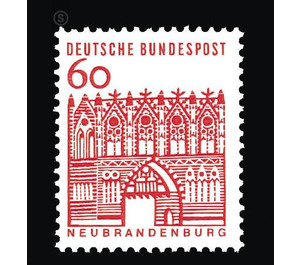Postage stamp: German buildings from twelve centuries - Germany / Federal Republic of Germany 1964 - 60
Theme: Architecture
| Country | Germany / Federal Republic of Germany |
| Issue Date | 1964 |
| Face Value | 60.00 |
| Color | red |
| Perforation | K 14 |
| Printing Type | Typography |
| Stamp Type | Postage stamp |
| Item Type | Stamp |
| Chronological Issue Number | 349 |
| Chronological Chapter | GER-BRD |
| SID | 542812 |
| In 46 Wishlists | |
After almost three and a half years, the postage stamp permanent series was replaced with portraits of great Germans. The preparatory work has been going on since the beginning of 1963. At that time a number of graphic artists were invited to submit sample proposals with one example each from Hesse and Bavaria, namely the Lorraine gatehouse from the Carolingian era and the well-known Ellinger Tor in Weissenburg. Two examples each went to Otto Rohse, Prof. Hans Michel and Günther Kieser, Karl Oskar Blase and graphic designers Hella and Heinz Schillinger. Siegfried Kortemeier presented three works, Prof. Richard Blank four and Erwin Poell eight works. These 25 sheets give a clear impression of the difficulty of the task of presenting buildings in the small format of the stamp in such a way that they appear as original graphic creations and not as mechanically produced diminutions. So it was clear from the beginning that the right measure was to be kept even when choosing the buildings. To be sure, with the help of today's highly developed reproduction and printing technology quite amazing achievements can be accomplished, and there is no longer the insurmountable difficulties that frighten away, for example, the gigantic building complex of Marienburg in East Prussia into the small square of the stamp hineinzupraktizieren. For all justifiable astonishment at such a technical miracle, however, it should not be forgotten that, viewed as an artistic beginning, it has its most questionable side. Therefore, only such buildings were included in the series whose meaning is not in the extent, but in the expression whose external dimensions do not overwhelm, but remain manageable. Thus, in their size, these often rather modest architectural structures are representative and emblematic of the architectural culture of the German homeland. for as artistic creations they "stand their man". The basic idea of this approach is the technique of wood engraving chosen by Otto Rohse. At the same time she gave the artist the opportunity to create out of the stamp format directly. For his designs are not much larger than the brand itself. The choice of the Art Advisory Council fell immediately to these proposals, which also recognized the Federal Minister of Posts and Telecommunications and intended to execute. The execution of the entire series, partly in letterpress and partly in intaglio printing, is once again in the proven hands of Bundesdruckerei Berlin. The postage stamps of the permanent series have been published at the same time and with the same motif as "Deutsche Bundespost Berlin".


